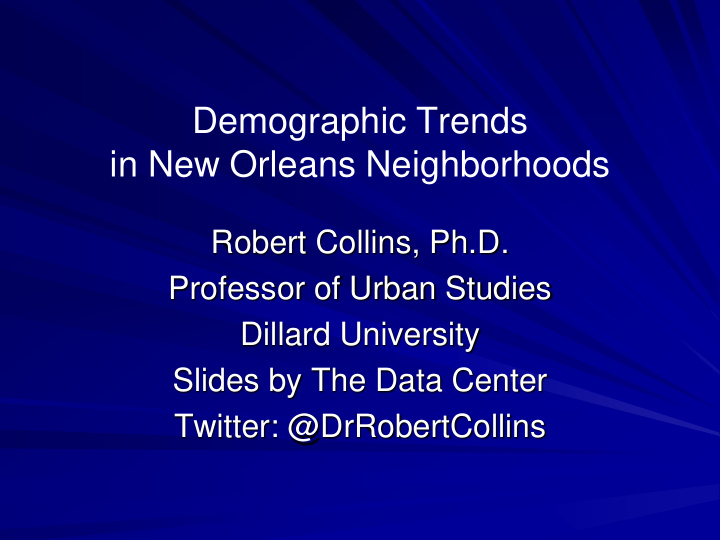



Demographic Trends in New Orleans Neighborhoods Robert Collins, Ph.D. Professor of Urban Studies Dillard University Slides by The Data Center Twitter: @DrRobertCollins
New Orleans has lost 283,000 residents since 1960 when its population peaked at 627,525, but from a geographic perspective the city has grown since 1960. Population New Orleans Sources: GNOCDC analysis of data from “ Bienville ’ s Dilemma ” by Richard Campanella and the U.S. Census Bureau.
Housing development and abandonment trends within the city since 1960. • 1960-1980: Suburban development expands. Historic neighborhoods experience abandonment. • 1980-2000: Oil bust pummels economy. City vacancy rate soars except in newest developments along fringe. • 1990-2000: Demand for CBD housing and in “ sliver by the river ” picks up. • 2000-2010: Levee failures lead to widespread losses of households. Singles are attracted to “ downtown living ” but more households move out of the other “ sliver ” neighborhoods than move in.
The areas of the city first to be developed were closer to the river in the more elevated parts of the city, and the last areas to be developed were the lowest lying sections of the city. Residential development zones New Orleans Sources: Campanella, R. (2002). Time and place in New Orleans: Past geographies in the present day. Gretna, Louisiana: Pelican Publishing.
Between 1960 and 1980, the number of occupied housing units in the city grew slightly even as population declined. Population and occupied housing units New Orleans Sources: GNOCDC analysis of data from the U.S. Census Bureau.
Density of occupied housing units in New Orleans, 1960 Source: GNOCDC analysis of data from the U.S. Census Bureau; Minnesota Population Center. National Historical Geographic Information System: Version 2.0 . Minneapolis, MN: University of Minnesota 2011.
Density of occupied housing units in New Orleans, 1980 Source: GNOCDC analysis of data from the U.S. Census Bureau; Minnesota Population Center. National Historical Geographic Information System: Version 2.0 . Minneapolis, MN: University of Minnesota 2011.
Density of occupied housing units in New Orleans, 2000 Source: GNOCDC analysis of data from the U.S. Census Bureau; Minnesota Population Center. National Historical Geographic Information System: Version 2.0 . Minneapolis, MN: University of Minnesota 2011.
Density of occupied housing units in New Orleans, 2010 Source: GNOCDC analysis of data from the U.S. Census Bureau; Minnesota Population Center. National Historical Geographic Information System: Version 2.0 . Minneapolis, MN: University of Minnesota 2011.
Katrina caused widespread losses in occupied housing units across the city from 2000 to 2010. Percent change in occupied housing units by census tract, 2000-2010 New Orleans Source: GNOCDC analysis of data from the U.S. Census Bureau. Note: GNOCDC aggregated 2000 census blocks to 2010 census tracts in order to calculate the change in occupied housing units by 2010 census tract. One census tract in Mid-City is white because it has zero occupied housing units in both 2000 and 2010. Another census tract in Viavant/ Venetian Isles is white because it had zero occupied housing units in 2000 and three in 2010, and thus experienced “ infinite ” growth.
From 1960 to 1980, suburban development, particularly in Jefferson Parish, dramatically shifted the concentration of households away from the city. Occupied housing units by parish New Orleans metro Sources: GNOCDC analysis of data from the U.S. Census Bureau.
From 1980 to 2000, growth in exurban parishes picks up pace. Occupied housing units by parish New Orleans metro Sources: GNOCDC analysis of data from the U.S. Census Bureau.
Between 2000 and 2010, Katrina accelerates the shifting of households to northern and western exurban parishes. Occupied housing units by parish New Orleans metro Sources: GNOCDC analysis of data from the U.S. Census Bureau.
New Comprehensive Zoning Ordinance Culmination of ten year post-Katrina recovery planning process. Implements many recommendations of master plan passed five years earlier. Improves transparency, reliability, and due process. Mitigates Preservation vs. Commerce. Some inclusionary zoning/affordable housing.
Conclusion Future amendments to the CZO might include more inclusionary zoning for affordable housing. The primary challenge will continue to be the city’s high poverty rate (27 percent). Without market interventions, current demographic trends will likely continue.
Demographic Trends in New Orleans Neighborhoods Robert Collins, Ph.D. Professor of Urban Studies Dillard University Slides by The Data Center Twitter: @DrRobertCollins
Recommend
More recommend